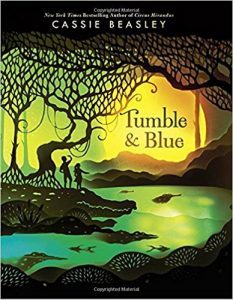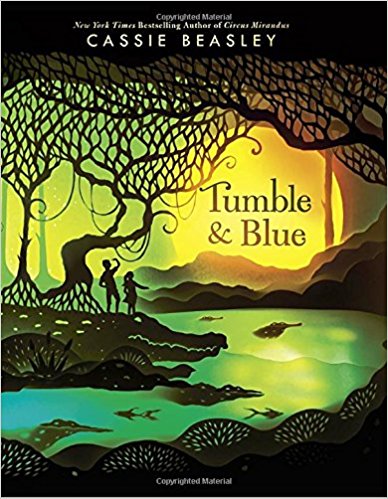craft review by Lindsay Lackey
During his keynote talk at an SCBWI conference in 2016, the late Richard Peck shared his tried and true method for creating a solid first chapter. He said, “I always go back and rewrite the first chapter from scratch after I’ve written the last chapter.”
He went on to explain that the first chapter must hold in its pages elements of the entire story. “You have to sprinkle it with clues,” he said. “So you have to know the end—you have to know the whole story—before you can really know how it begins.”
So, do excellent first chapters really contain important clues and elements for the whole book? Let’s look at the first chapter of Cassie Beasley’s Tumble and Blue as an example. (See our craft review on multiple points of view in Tumble and Blue here.)
 The first line of the book reads: “Blue Montgomery almost missed the sign.” Here we meet Blue, one of the book’s main characters, and initially, we take this first sentence literally. He is in a car and almost doesn’t see the sign for Kudzu, the small Georgia town in which the book is set.
The first line of the book reads: “Blue Montgomery almost missed the sign.” Here we meet Blue, one of the book’s main characters, and initially, we take this first sentence literally. He is in a car and almost doesn’t see the sign for Kudzu, the small Georgia town in which the book is set.
But Blue Montgomery isn’t a typical kid. He’s a kid who loses. It’s his fate. And so the fact that he almost misses the sign for a place that plays an important role in his fate is a subtle but masterful foreshadowing of an aspect of Blue’s character. Beasley demonstrates Blue’s inability to win over and over in the first few pages without ever directly mentioning it. Blue can’t even manage to beat his dad in a grab for his duffle bag. These subtle details prepare us for the revelation that Blue is cursed to lose—which, of course, gets us rooting for him.
When Blue sets sight on his grandmother’s ancient house, he notes some details about it for the reader:
“Carved over the front door’s lintel was a scene that had been painted over so many times the finer details were obscured. Two figures, a man and a woman, were shaking hands under a crescent moon.”
These details give us a clear picture of the house as a place that is old and ornate, but has grown shabby with years of sloppy repairs. Again, Beasley has layered important story elements into a small detail. Not only do we see the man and woman under the moon—characters who are the cornerstone for Blue’s entire family history—but we learn that the details of their story have been forgotten. Because his family has been sloppy in remembering their own history, Blue’s quest to rewrite his fate is all the more complicated.
As Blue’s father prepares to leave him behind, he says to Blue, “Just take care of yourself.” This is a heartbreaking moment for Blue, and the spare dialogue is like a jab in Blue’s—and our—ribs. Yet once again, Beasley has done something masterful in a few small words. Though Blue knows he is destined to lose, he ultimately takes his father’s advice to heart. Initially, he is convinced his father will return to take care of him. By the end of the book, we see how Blue learns to trust himself. He’s learned that he does not have to be resigned to his fate. He can take care of himself.
Beasley gives another hint at Blue’s story arc with the final lines of the chapter:
“Racing shoes, he thought. Not-for-Blue shoes.
And when he stuffed his bare feet inside of the shoes, they fit. Like they had been waiting for him.
Like they were ready to try something new.”
The end of the chapter gives us a sense that the story knows where it’s going. We’ve met a kid who wants to change his future, and we’re rooting for him. Beasley has laid out a series of hints as to what we can expect from this book: forgotten histories, a cursed but resilient boy, and the hope of a new fate. It’s clear the author knows the whole story, and because of that, we are given a beginning that makes us want to keep reading.
Action: When you’ve finished your manuscript, go back and rewrite your first chapter. What elements or themes can you better layer in now that you know the whole story? How can you strengthen your reader’s impression of the character through small, foreshadowing detail? In what ways does your first chapter hint at the entire story arc?
Lindsay Lackey is an author of middle grade fiction and former library services worker. She was born in Colorado, but now lives in the San Francisco Bay Area with her husband and their spoiled dog. ALL THE IMPOSSIBLE THINGS is her debut novel.
Find her at www.lindsaylackey.com


COMMENTs:
0